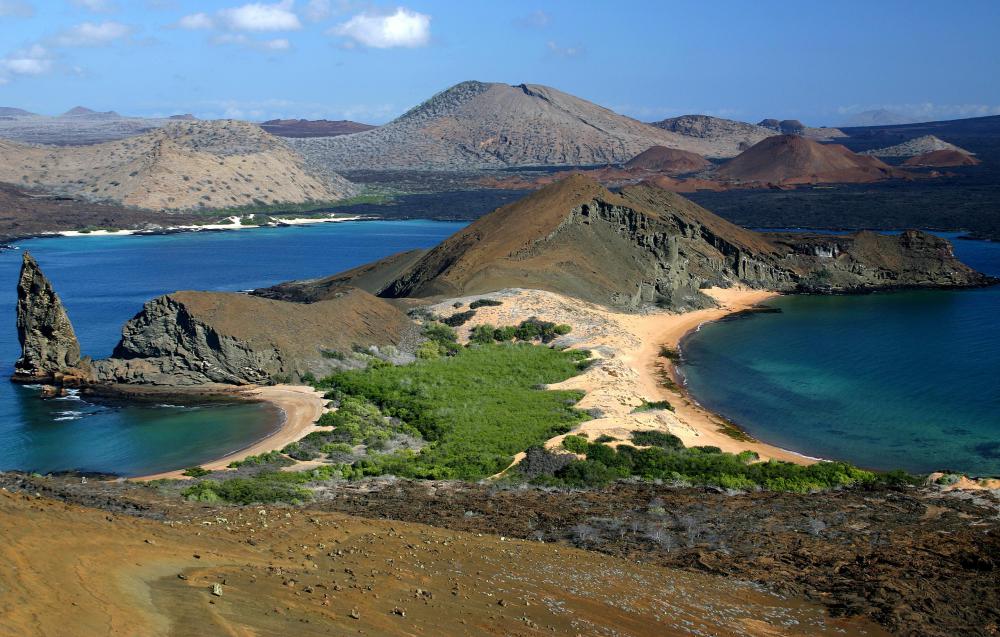At AllThingsNature, we're committed to delivering accurate, trustworthy information. Our expert-authored content is rigorously fact-checked and sourced from credible authorities. Discover how we uphold the highest standards in providing you with reliable knowledge.
What is a Marine Iguana?
The marine iguana is native to the Galapagos Islands off the western coast of South America. This iguana species is the only one that swims in the ocean and feeds off aquatic algae. Slow and clumsy on land, the marine iguana is fast and powerful in the water—adult marine iguanas can dive to depths of almost 50 feet (15 meters), though they generally stay nearer to the surface. The male marine iguana, at 4.27 feet (1.3 meters), is usually larger than the female. Adult iguanas are typically, black but can be several other colors, including green and red.
Like most iguanas, marine iguanas are primarily herbivorous, typically feeding on algae that grows on underwater or tidal pool rocks. Unlike other iguanas, which have pointed snouts, marine iguanas have blunted noses that help them get closer to the rocks where their food supply grows. Marine iguanas have long, curved claws that help them cling to the lava rocks while searching for food. They also have a special salt-expelling gland to remove the huge amounts of salt they ingest while feeding underwater. Before and after marine iguanas dive in the cold ocean waters to feed, they typically bask in the sun to raise their body temperature.

Though some species of iguana, like the blue iguana, are rare or critically endangered, the marine iguana population is reported to be over 200,000-strong. This is generally due to the strict Ecuadorian laws protecting this Galapagos reptile. Marine iguanas are considered to be vulnerable, however, due to increasing numbers of non-native species as predators and the periodic destruction of a reported 85% of the marine iguana population by harmful weather conditions.

Land predators of the eggs and young of marine iguanas include snakes, rats, hawks, and wild dogs and cats. While foraging for food in the waters along the Galapagos shoreline, marine iguanas are often susceptible to shark attack. They are also at risk for damage from oil spills.
The greatest threat to the marine iguana is its own environment. The seasonal El Nino weather conditions warm up the water around the Galapagos Islands and reduce the amount of edible algae. During this food scarcity, the marine iguana population typically drops off dramatically due to starvation. This hardy reptile has adapted to deal with this occasional reduction in food by shrinking its body. Consuming its own bones, the marine iguana can wait out famine, and once the food supply becomes viable again, these iguanas usually rebound to their original adult size.
Frequently Asked Questions
What is a marine iguana and where can it be found?

The marine iguana (Amblyrhynchus cristatus) is a unique species of iguana found only on the Galápagos Islands. Adapted to a life both on land and in the sea, it's the only lizard that swims in the ocean, foraging for algae and seaweed on rocky shores. Their distinctive appearance and behaviors are a result of millions of years of evolution in this isolated environment.
How does the marine iguana adapt to its aquatic lifestyle?
Marine iguanas have several adaptations for their aquatic lifestyle. They possess flattened tails to aid in swimming, sharp claws for clinging onto rocks against strong currents, and laterally compressed bodies to streamline movement in water. According to research, they can also shrink their bones to cope with food scarcity, a remarkable adaptation for survival.
What do marine iguanas eat and how do they feed?
Marine iguanas primarily feed on algae and seaweed, which they graze from the rocky ocean floor. They have developed blunt snouts and strong teeth to scrape their food off rocks. During low tide, they may also forage along the shoreline. Their diet is highly specialized, which limits their habitat to areas where these food sources are abundant.
Are marine iguanas endangered?
Marine iguanas are currently listed as vulnerable by the IUCN Red List of Threatened Species. They face threats from invasive species, habitat degradation, and climate change, which can lead to food scarcity. Conservation efforts in the Galápagos Islands aim to protect these unique reptiles and their delicate ecosystem from further harm.
How do marine iguanas regulate their body temperature?
As cold-blooded reptiles, marine iguanas rely on external heat sources to regulate their body temperature. They bask in the sun to warm up after swimming in the cooler waters of the Galápagos. Their dark skin helps in absorbing heat more efficiently, and they can be seen huddling together to minimize heat loss on colder days.
What is the social behavior of marine iguanas?
Marine iguanas display varying social behaviors. They are generally solitary but come together in large groups during the breeding season. Males can become territorial and may engage in head-bobbing displays or physical confrontations to assert dominance. Outside of breeding, they are known to rest in communal piles, which helps conserve warmth.
AS FEATURED ON:
AS FEATURED ON:













Discuss this Article
Post your comments